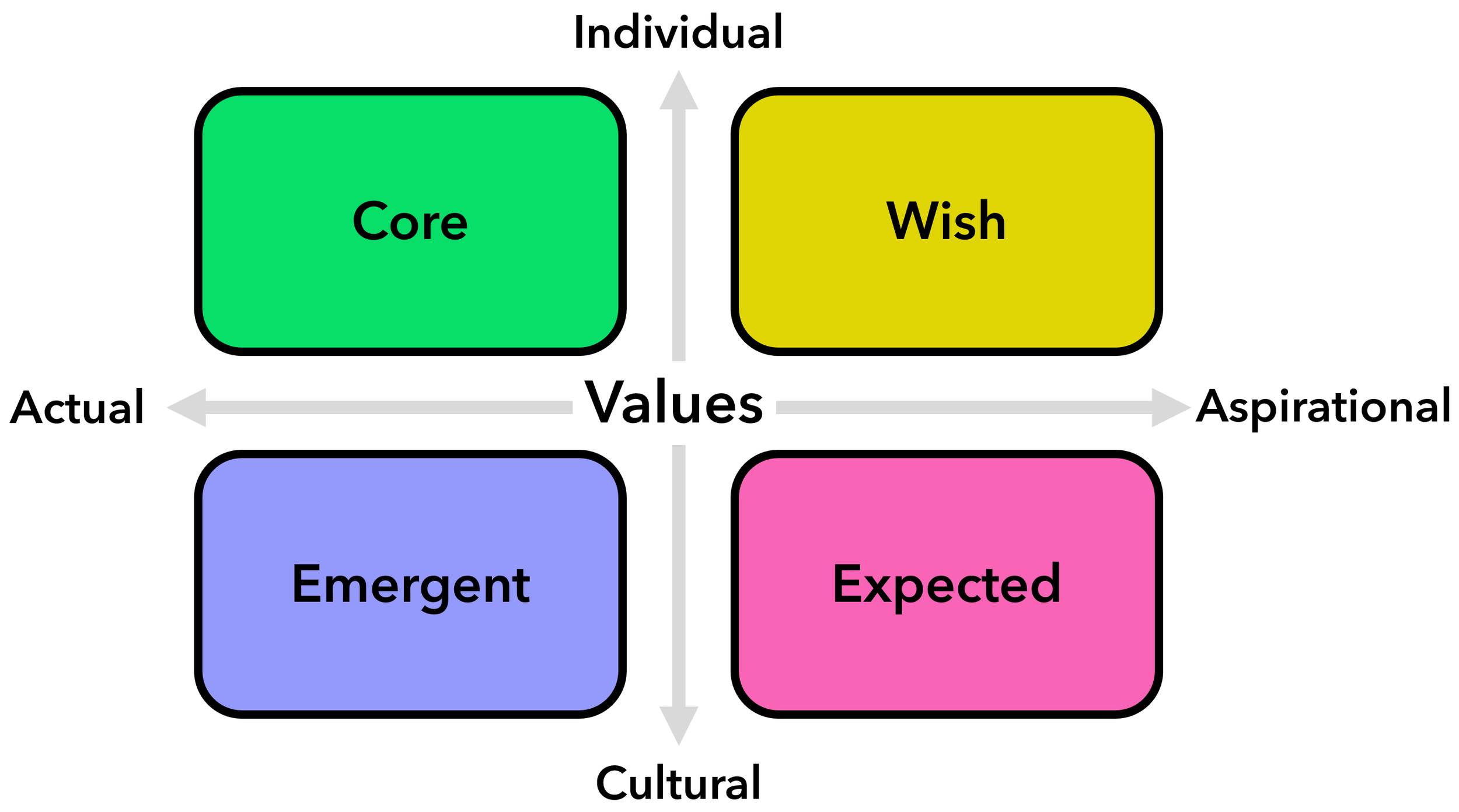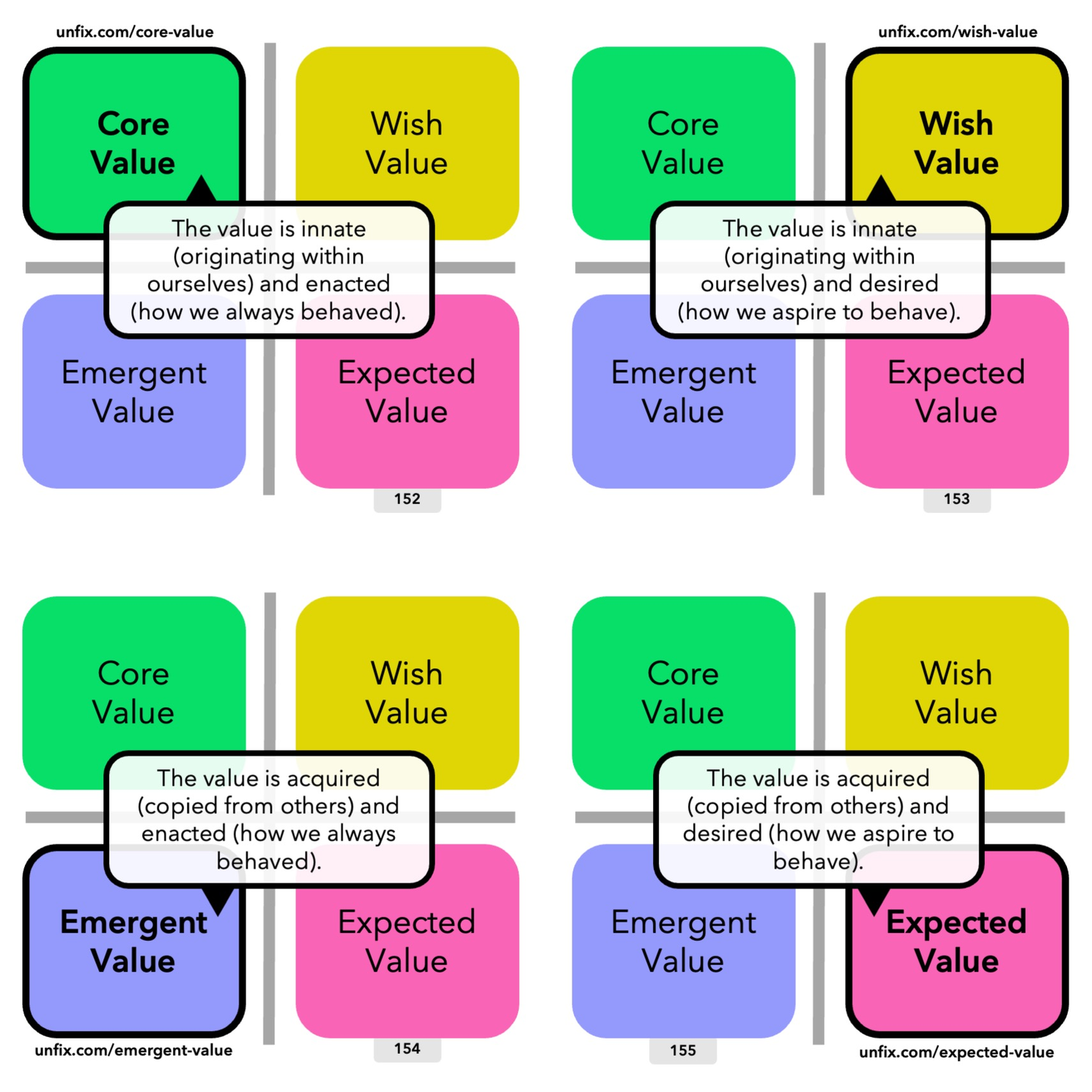Behavioral Values - Core, Wish, Emergent, Expected
Author: Jurgen Appelo
What is our ethical framework? Figuring out how our team members should behave toward each other and toward our stakeholders is (and should be) a never-ending discussion. But it's good to have a starting point.
I decided to begin with Try Things, Add Value, and Be Fair.
We must have an experimental mindset (Try Things), aim to address the needs and desires of stakeholders (Add Value), and practice radical openness and transparency (Be Fair).
In any organization or team, defining and living by behavioral values is crucial for creating a positive culture and achieving success. Behavioral values are guiding principles that help individuals and groups understand how they should behave in different situations. These values are important because they establish a standard for behavior, set expectations for performance, and provide a framework for decision-making.
Behavioral values are guiding principles that help individuals and groups understand how they should behave in different situations.
Two scales of values
We distinguish between individual values and cultural values.
Individual values (Core Value or Wish Value) are the principles that guide an individual's behavior and actions. Some things are important because we put them on the agenda ourselves. We feel they come from within, and we don't want to live and work in an environment that doesn't recognize our needs and desires.
Cultural values (Emergent Value or Expected Value), on the other hand, are the shared beliefs and behaviors that define a group or organization's culture. These values come from the environment we are part of, and we embrace them because we acknowledge the needs and desires of the people around us.
Note: There is no rigid separation between individual and cultural values. Individual behaviors are culturally influenced, and culture is the emergent result of individual behaviors in an interdependent group.
Another distinction we can make is between actual values and aspirational values.
Actual values (Core Value or Emergent Value) are the behaviors that individuals and teams currently exhibit. They reflect the current state and provide insights into the organization's or team's strengths and weaknesses. By understanding the actual (enacted) values, individuals and teams can identify areas where they excel and areas where they need to improve.
Aspirational values (Wish Value or Expected Value), on the other hand, are the behaviors and actions that individuals and teams strive to achieve. By setting aspirational values, individuals and groups can identify the behaviors and activities they want to exhibit. They represent the ideal state that the organization or team aspires to create.
Note: There is also no rigid separation between actual and aspirational values, as they exist on a continuum. Some values come naturally to people; others are difficult to adopt, and most are somewhere in between.
The matrix described above gives us four kinds of values:
Core Value: The value is innate (originating within ourselves) and enacted (how we always behaved).
Wish (Aspirational) Value: The value is innate (originating within ourselves) and desired (how we aspire to behave).
Emergent (Accidental) Value: The value is acquired (copied from others) and enacted (how we always behaved).
Expected (Permission-to-Play) Value: The value is acquired (copied from others) and desired (how we aspire to behave).
Three good reasons to define behavioral values
Discussing behavioral values is vital for several reasons.
First, it sets clear expectations for behavior and performance. When individuals and teams clearly understand what is expected of them, they are more likely to meet those expectations. This leads to increased productivity and better decision-making.
Second, defining behavioral values helps to create a strong and positive culture. When individuals and teams share common values and beliefs, they are more likely to work together cohesively and support one another. This creates a sense of community and fosters a positive work environment that supports the well-being of all members.
Third, when individuals and teams understand the values and beliefs of the organization or team, they are more likely to feel a sense of direction in their work. This should also lead to increased motivation, engagement, and job satisfaction.
Try Things, Add Value, and Be Fair
The two-by-two grid of behavioral values is one of many examples where I tried something new. This simple tool can be of value to some of our readers. Finally, fairness requires me to explain that the four value types are inspired by the work of Patrick Lencioni (who identified the same four types but did not offer a diagram for visualization).
To define and live by behavioral values, individuals and teams must be committed to the process. This requires ongoing communication, feedback, and a willingness to adapt and change as needed. It also requires leadership committed to creating a positive culture and supporting the well-being of all members.
Defining and living by behavioral values is crucial for creating a positive culture and achieving success in any organization or team. Individual and cultural values, as well as actual and aspirational values, are all essential components of this process. By defining and living by behavioral values, individuals and teams can set clear expectations, create a positive culture, and work towards a common goal.


